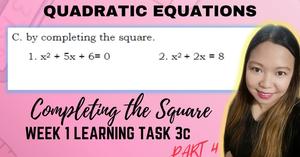Solve the following quadratic equations by completing the square: 1. x² - 5x + 6 = 0; 2. x² + 2x = 8.

Understand the Problem
The question is asking for solutions to quadratic equations using the method of completing the square. The task includes two specific equations to solve.
Answer
1. $x = -2, -3$; 2. $x = 2, -4$
Answer for screen readers
The solutions are:
-
For $x^2 + 5x + 6 = 0$: $x = -2$ or $x = -3$.
-
For $x^2 + 2x = 8$: $x = 2$ or $x = -4$.
Steps to Solve
- Solve the first equation: $x^2 + 5x + 6 = 0$
To complete the square, first rearrange the equation: $$ x^2 + 5x = -6 $$
Next, find the term to complete the square. Take half of the coefficient of $x$, which is $\frac{5}{2}$, and square it: $$ \left(\frac{5}{2}\right)^2 = \frac{25}{4} $$
Add $\frac{25}{4}$ to both sides: $$ x^2 + 5x + \frac{25}{4} = -6 + \frac{25}{4} $$
Convert $-6$ into quarters: $$ -6 = -\frac{24}{4} $$
Combine the right side: $$ x^2 + 5x + \frac{25}{4} = \frac{1}{4} $$
Now rewrite the left side as a square: $$ \left(x + \frac{5}{2}\right)^2 = \frac{1}{4} $$
Take the square root of both sides: $$ x + \frac{5}{2} = \pm \frac{1}{2} $$
Solve for $x$: $$ x = -\frac{5}{2} + \frac{1}{2} \quad \text{or} \quad x = -\frac{5}{2} - \frac{1}{2} $$
This gives: $$ x = -2 \quad \text{or} \quad x = -3 $$
- Solve the second equation: $x^2 + 2x = 8$
Rearrange the equation: $$ x^2 + 2x - 8 = 0 $$
Now isolate $x^2 + 2x$: $$ x^2 + 2x = 8 $$
Next, find the term to complete the square. Take half of the coefficient of $x$, which is $1$, and square it: $$ 1^2 = 1 $$
Add $1$ to both sides: $$ x^2 + 2x + 1 = 8 + 1 $$
This simplifies to: $$ (x + 1)^2 = 9 $$
Take the square root of both sides: $$ x + 1 = \pm 3 $$
Solve for $x$: $$ x = -1 + 3 \quad \text{or} \quad x = -1 - 3 $$
This gives: $$ x = 2 \quad \text{or} \quad x = -4 $$
The solutions are:
-
For $x^2 + 5x + 6 = 0$: $x = -2$ or $x = -3$.
-
For $x^2 + 2x = 8$: $x = 2$ or $x = -4$.
More Information
Completing the square is a method used to solve quadratic equations by converting them into perfect square trinomials. This technique provides both the roots of the equations and insights into the vertex of the parabolas they represent.
Tips
- Forgetting to add or subtract the necessary square term correctly can lead to incorrect equations.
- Not simplifying fractions properly, especially when working with common denominators.
AI-generated content may contain errors. Please verify critical information